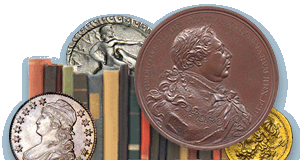
PREV ARTICLE
NEXT ARTICLE
FULL ISSUE
PREV FULL ISSUE
LOOSE CHANGE: JUNE 8, 2025Here are some additional items in the media this week that may be of interest. -Editor Andrew Crellin of Sterling and Currency published an article summarizing the Australian 2025 "State of Collectables" Report by eBay and Deloitte Access Economics. -Editor The fact that coins topped the collecting charts didn't surprise me. That was the case back in 2023 and much earlier when AC Nielsen conducted similar research for eBay in 2004.
To read the complete article, see:
A Greysheet article by Greg Reynolds discusses the 1814 Capped Bust Half Dollar. -Editor It is sad that a regular date, which is not characterized by repunching in the die or by very apparently unusual numerals, is typically called a normal date! The use of the term normal for regular numerals incorrectly implies that overdates and pertinent anomalies, like a small numeral, are abnormal. Almost all such varieties stem from standard practices and procedures of the first U.S. Mint, and are factors in the personalities of coins. They are not abnormal. Readily apparent minting anomalies are often seen on U.S. coins dating before 1836. As a result of varieties relating to numerals receiving so much attention, early Capped Bust halves with a regular date are often overlooked. A Capped Bust half with regular numerals and no very noticeable anomalies is less likely to be accompanied by commentary than a Capped Bust half from the same year that is an overdate or features noticeable peculiarities. Reportedly, more than one million 1814 halves were minted. This total includes 1814/3 halves. It is likely that fewer than ten thousand survive, including both 1814 regular date and 1814/3 overdate half dollars.
To read the complete article, see:
Another Greysheet article discusses some additional highlights of the upcoming sale 103 from Archives International Auctions. -Editor Among the marquee highlights are three extraordinary interest-bearing notes from the Civil War era, each representing a crucial financial innovation during one of America's most challenging times:
Each of these notes is a rare survivor of a period when the U.S. government used interest-bearing currency to fund the war effort—most were redeemed and destroyed, making surviving examples highly desirable. Equally significant is a newly surfaced pair of ca. 1836–1839 Citizens' Bank of Louisiana interest-bearing proof notes—a $100 and $500 post note—both believed to be unique discovery pieces. Printed on india paper with engraved interest coupons and designed to pay 5½% interest annually, these historic notes reflect the financial ingenuity of antebellum Louisiana and predate federal interest-bearing currency by decades. Never before seen at auction, they offer a rare glimpse into early American fiscal policy and banking.
To read the complete article, see:
To read the earlier E-Sylum article, see:
Last week I discussed my Pittsburgh museum visits and appreciation for stained glass. Here's a non-numismatic article about Tiffany Studios' glass that readers may enjoy. -Editor
Revered in their time, the studio's beautiful creations gestated and languished until near the dawn of the age of Aquarius. Then, in 1958, Tiffany's first major retrospective, at the Museum of Contemporary Crafts in New York, saw his and his studio's work reappreciated. Only then were the lamps, vases, windows and other objects of design able to be fully recognized as works of unparalleled art, not just innovative and expensive tabletop and cabinet curiosities for the wealthy, as they were originally marketed. There have always been cognoscenti who loved Tiffany. The great "for instance" is Andy Warhol, who kept a Tiffany lamp next to his Federal-style four-poster bed. The association between Tiffany lamps and Pop Art and hippiedom is no surprise; I am repeatedly amazed when I look at some of those early Favrile vases and their swirling, dizzying psychedelia. The thread from those to a Fillmore-era Grateful Dead poster or an Exploding Plastic Inevitable happening is easily connected.
To read the complete article, see:
The article promotes an upcoming Sotheby's sale of Tiffany works. If any of our readers buys this window, let me know and I'll come visit. -Editor
To read the complete lot description, see:
To read the earlier E-Sylum articles, see:
Wayne Homren, Editor The Numismatic Bibliomania Society is a non-profit organization promoting numismatic literature. See our web site at coinbooks.org. To submit items for publication in The E-Sylum, write to the Editor at this address: whomren@gmail.com To subscribe go to: Subscribe All Rights Reserved. NBS Home Page Contact the NBS webmaster 
|




